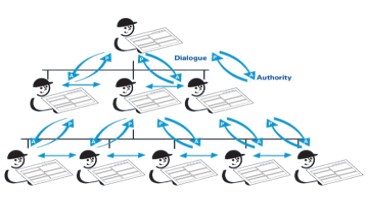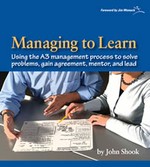Toyota’s Secret: The A3 Report – MIT Sloan Management Review Article by John Shook
How Toyota solves problems, creates plans, and gets new things done while developing an organization of thinking problem-solvers.
In this Sloan Management Review article from 1st July 2009, John Shook created an article in A3 format about the A3 process! It’s a useful article as it summarises the intent in the Managing to Learn book.
The full article can be read here: Toyota’s Secret: The A3 Report
While much has been written about Toyota Motor Corp.’s production system, little has captured the way the company manages people to achieve operational learning. At Toyota, there exists a way to solve problems that generates knowledge and helps people doing the work learn how to learn.

Company managers use a tool called the A3 (named after the international paper size on which it fits) as a key tactic in sharing a deeper method of thinking that lies at the heart of Toyota’s sustained success.
A3s are deceptively simple. An A3 is composed of a sequence of boxes (seven in the example) arrayed in a template. Inside the boxes the A3’s “author” attempts, in the following order, to:
- (1) establish the business context and importance of a specific problem or issue
- (2) describe the current conditions of the problem
- (3) identify the desired outcome
- (4) analyze the situation to establish causality
- (5) propose countermeasures
- (6) prescribe an action plan for getting it done
- (7) map out the follow-up proces
However, A3 reports — and more importantly the underlying thinking — play more than a purely practical role; they also embody a more critical core strength of a lean company. A3s serve as mechanisms for managers to mentor others in root-cause analysis and scientific thinking, while also aligning the interests of individuals and departments throughout the organization by encouraging productive dialogue and helping people learn from one another. A3 management is a system based on building structured opportunities for people to learn in the manner that comes most naturally to them: through experience, by learning from mistakes and through plan-based trial and error.
The A3s reproduced in the article represent some of the stages in a typical development sequence. The example is drawn from Managing to Learn, by John Shook, The Lean Enterprise Institute, 2008.)

Organizations use A3s to get decisions made, distribute authority to the level needed for good decisions, align people and teams on common goals and learn for constant improvement.
The ultimate goal of A3s is not just to solve the problem at hand, but to make the process of problem solving transparent and teachable in a manner that creates an organization full of thinking, learning problem solvers. In this way, the A3 management process powerfully embodies the essence of operational learning.
Read more about the A3 Process in the book managing to learn
-
 Managing to Learn£44.00
Managing to Learn£44.00
Now move on to the next Lesson – Fundemental A3 Principles